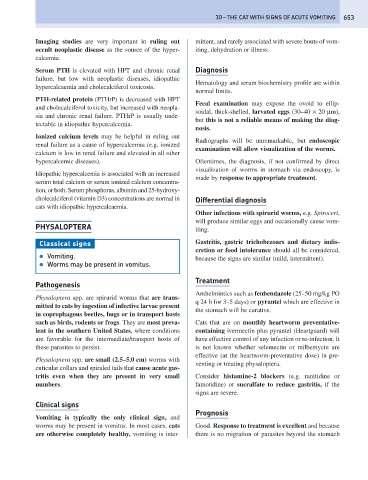Page 661 - Problem-Based Feline Medicine
P. 661
30 – THE CAT WITH SIGNS OF ACUTE VOMITING 653
Imaging studies are very important in ruling out mittent, and rarely associated with severe bouts of vom-
occult neoplastic disease as the source of the hyper- iting, dehydration or illness.
calcemia.
Serum PTH is elevated with HPT and chronic renal Diagnosis
failure, but low with neoplastic diseases, idiopathic
Hematology and serum biochemistry profile are within
hypercalcaemia and cholecalciferol toxicosis.
normal limits.
PTH-related protein (PTHrP) is decreased with HPT
Fecal examination may expose the ovoid to ellip-
and cholecalciferol toxicity, but increased with neopla-
soidal, thick-shelled, larvated eggs (30–40 × 20 μm),
sia and chronic renal failure. PTHrP is usually unde-
but this is not a reliable means of making the diag-
tectable in idiopathic hypercalcemia.
nosis.
Ionized calcium levels may be helpful in ruling out
Radiographs will be unremarkable, but endoscopic
renal failure as a cause of hypercalcemia (e.g. ionized
examination will allow visualization of the worms.
calcium is low in renal failure and elevated in all other
hypercalcemic diseases). Oftentimes, the diagnosis, if not confirmed by direct
visualization of worms in stomach via endoscopy, is
Idiopathic hypercalcemia is associated with an increased
made by response to appropriate treatment.
serum total calcium or serum ionized calcium concentra-
tion, or both. Serum phosphorus, albumin and 25-hydroxy-
cholecalciferol (vitamin D3) concentrations are normal in Differential diagnosis
cats with idiopathic hypercalcaemia.
Other infections with spirurid worms, e.g. Spiroceri,
will produce similar eggs and occasionally cause vom-
PHYSALOPTERA iting.
Classical signs Gastritis, gastric trichobezoars and dietary indis-
cretion or food intolerance should all be considered,
● Vomiting. because the signs are similar (mild, intermittent).
● Worms may be present in vomitus.
Treatment
Pathogenesis
Anthelmintics such as fenbendazole (25–50 mg/kg PO
Physaloptera spp. are spirurid worms that are trans-
q 24 h for 3–5 days) or pyrantel which are effective in
mitted to cats by ingestion of infective larvae present
the stomach will be curative.
in coprophagous beetles, bugs or in transport hosts
such as birds, rodents or frogs. They are most preva- Cats that are on monthly heartworm preventative-
lent in the southern United States, where conditions containing ivermectin plus pyrantel (Heartguard) will
are favorable for the intermediate/transport hosts of have effective control of any infection or re-infection. It
these parasites to persist. is not known whether selemectin or milbemycin are
effective (at the heartworm-preventative dose) in pre-
Physaloptera spp. are small (2.5–5.0 cm) worms with
venting or treating physaloptera.
cuticular collars and spiraled tails that cause acute gas-
tritis even when they are present in very small Consider histamine-2 blockers (e.g. ranitidine or
numbers. famotidine) or sucralfate to reduce gastritis, if the
signs are severe.
Clinical signs
Prognosis
Vomiting is typically the only clinical sign, and
worms may be present in vomitus. In most cases, cats Good. Response to treatment is excellent and because
are otherwise completely healthy, vomiting is inter- there is no migration of parasites beyond the stomach

